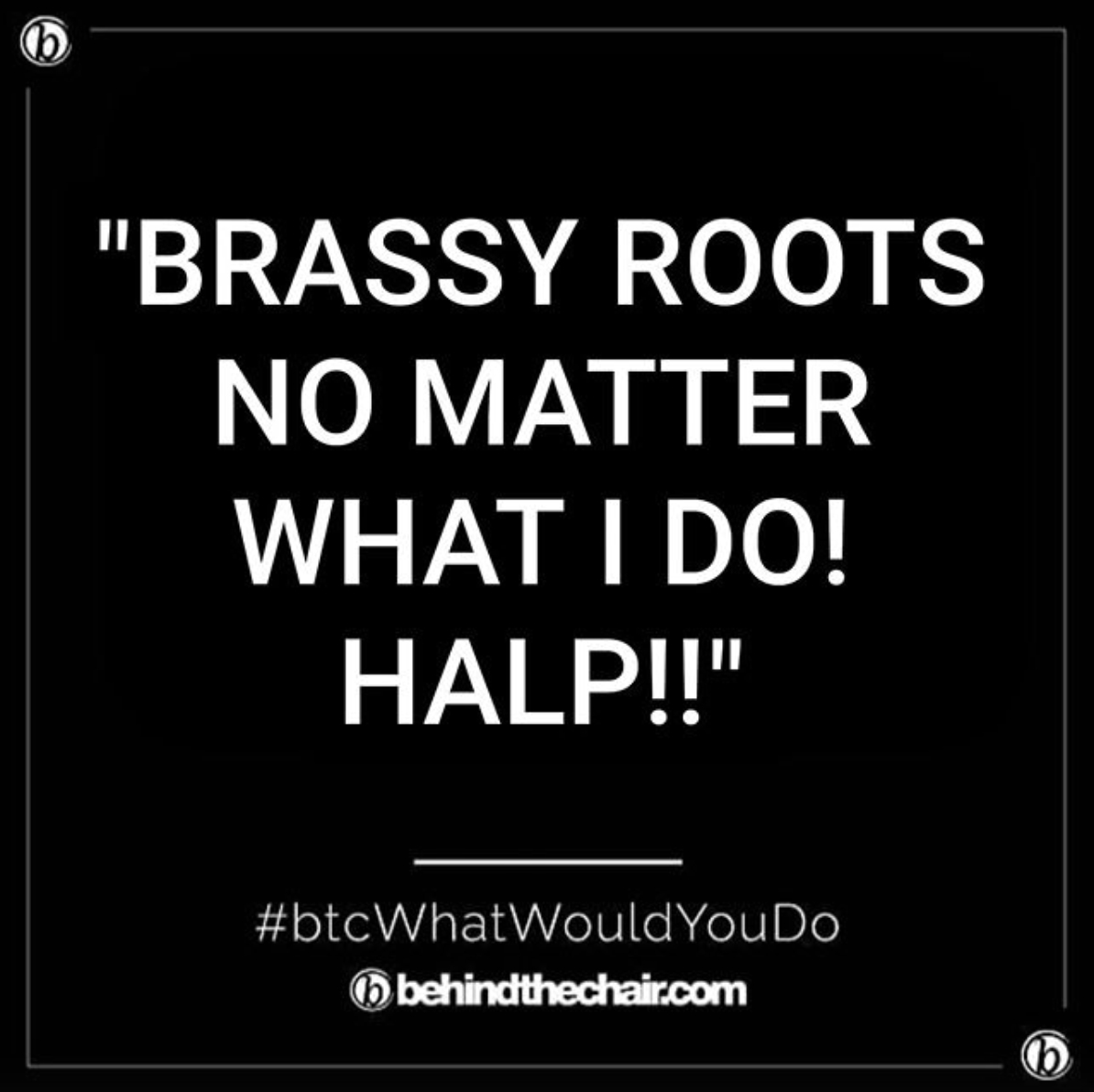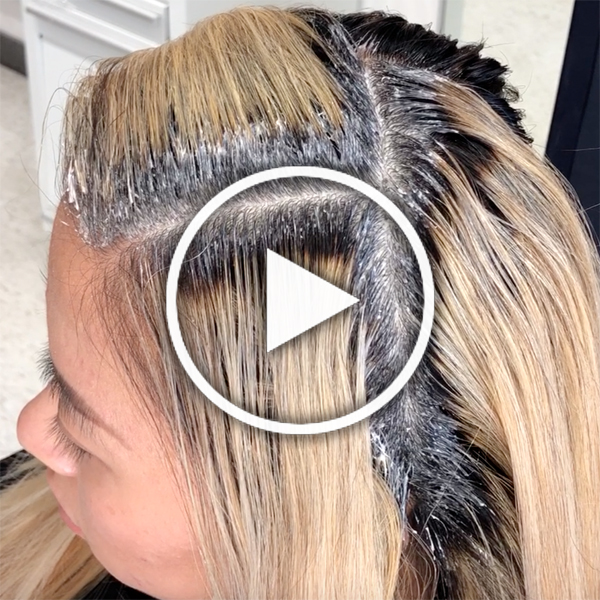What Would You Do: When Breaking The Base Always Results In Brassy Roots
Advice From Stylists On How To Avoid Brassy Roots When Base Breaking
When the goal is an ashy blonde with cool-toned roots, there’s nothing worse than breaking the base and being left with brassy roots. So what went wrong? One frustrated stylist dealing with this exact issue reached out for help, so we turned to the BTC Community to see what advice they would have. Keep scrolling to learn what could have caused the brassy roots, plus their suggestions on how to avoid them!
“My client is a natural Level 7 and heavily highlighted. It seems like no matter what formula I use to break the base, the roots appear brassy. But without breaking the base, I feel there is a distinct line between the regrowth and the highlights, and at times, the highlights appear yellow. Her goal is a pale, ash blonde with natural, cool roots. Is this possible?”
Need some advice? DM us on Instagram and Facebook!
What Could Have Gone Wrong
“You’re either not leaving the lightener on long enough to reach the correct underlying pigment or you’re using too light of a toner. Ashes are a little tricky, too. If you are trying to get an ash, you usually have to go one to two shades darker to achieve the correct results with most color lines. Or if you use a toner that has ammonia in it, it will lift the natural root slightly, making it look brassy.” – @charly_frisby
“Using too high of a developer and/or letting it process for too long. Base breaking should be a quick, gentle process.” – Chauntel Songy
“I’m wondering if there is a medication your client might be on that could be affecting this result?” – @krisborgen
“Is she coming in with oily hair? That would cause brass.” – @hair_byantonia
“I would switch to a single process color instead of breaking the base. Permanent color lifts first, then deposits the second half of processing, so you aren’t getting enough deposit to neutralize the orange undertones.” – Antonia Galluzzi Heironimus
“Sounds like the base break is the culprit! Also, sometimes those Level 7 babes have that underlying strawberry or ginger factor. The size of that color molecule is super large, resulting in a highly resistant situation—especially if you’re only going in with a base break. Maybe try a root tap with a 6 or 7NA instead.” – @studio_wolf
Do A Shadow Root Instead
“Base breaks are always brassy. Work with softening the foils at the root and doing a soft shadow root for a low-maintenance grow out. Do a nice bright pop around the face if she doesn’t feel blonde enough.” – @hairbykatied
“Do a subtle root smudge and maybe just break the base around her face. Breaking the base always come up warm. It only utilizes the lifting part of color and not the deposit, which is the control. So, if it were my client, I would pack in a bunch of fine highlights, smudge her root with a Level 7 or 8 and tone her ends. Optionally, break her base the half inch around her hairline, which is finer and typically lighter, so you won’t be fighting warmth as much.” – @thecoolestrobinyouknow
“I would do a root tap or shadow root instead of a base break! You’ll have way more control since you aren’t lifting at all.” – @bleach.it.again
“Do a permanent root color with blue and green in the formula. Level 7 is where orange and red will always live so you have to put in lots of tone to counteract. That’s the only way to get a neutral/cool color. Also, I recommend a purple shampoo or mask for in between appointments.” – @jayyelaine
“I had this exact problem. Do a shadow root with a demi. It was a little scary but so worth it!” – @angipineapplejunglejuice
“Stop breaking the base. It’s the opposite of what you/she wants. Instead of trying to lift the base to make it closer to the highlight, you can shadow the root to blend the highlights with the base. You only need to bring it down a level or two (a Level 8 or 9 natural ash of some kind will be fine) and a half inch to an inch of shadow will do. If you are looking to avoid exposing any warmth, you might want to look into using an acidic demi like Redken Shades EQ or L’Orèal Professionnel DIA Light, especially if they have fine hair.” – @_hair_alchemist_
Or Take Thinner Highlight Sections
“Take thinner highlight sections. Maybe you aren’t getting enough saturation for good lift. Also, process until the palest yellow, then I’d go back in and just tap in a root smudge of an ash color.” – Jenn Kohrs Rogers
“I wouldn’t shift her base because it’s always going to go warm. I’d stick with really fine babylights close to the root so the root will appear lighter without shifting the base and exposing warmth!” – @artistrybyelle
“Don’t break the base. Simply do highlights using Wella Professionals BLONDOR + 20-volume developer brought up to pale yellow. Then, tone for three minutes using Redken Shades EQ Gloss 10T + Shades EQ Processing Solution.” – Carolyn Hornbaker-Summers
“Thinner slices when highlighting, don’t break the base and apply a root tap after you rinse out the lightener.” – @heatherpaints_hair
“You need to stop coloring her roots! If you do babylights around the face and through the top and feather your lightener, you give a shadowed effect. It will greatly reduce any harsh line that exists. Let that lightener sit until it’s DONE! It will be beautiful! Trust.” – @garland.stebbins
“Don’t break the base. Take thinner sections and more of them if you don’t want a distinctly highlighted look….Either babylight for a more natural look or just take more sections and make them very fine for a blended appearance. Another option would be to shadow root if she likes that look.” – Brittany Spearns
Other Solutions To Possibly Try
“Goldwell has a 5-minute base upgrade. It only softens the root half a shade to one full shade. Super subtle, doesn’t lift warm at all but I would only use it on a Level 7 or lighter—and don’t leave it on longer than five minutes or it can go warm! So follow the directions! Subtle enough to not have a grow out line but just enough to give you an all-over lighter feel.” – @laurencheriee
“I wonder if your client is on medication. My client is and the medication and her hair reacts to the color. I add extra ash and pearl.” – Bec Findlay
“Schwarzkopf Professional IGORA COLOR10 9.12 + 20-volume developer. Process for seven minutes.” – @vladana.k_90
“Try a 10-volume developer instead of a 20-volume developer. That has helped me with one of my brassy clients.” – @sarah_nicole134
“I would pack foils in super close together and paint a Level 7 demi (choose a formula with something like 7NA to counteract her naturally warm base). The demi won’t lighten her base but it can cool it off so that it blends more seamlessly with her cool-toned highlights!” – @_tldesigns
See what other stylists had to say on Instagram and Facebook!
How To Break The Base With Haircolor in 10 Minutes: When, Why & What To Formulate









